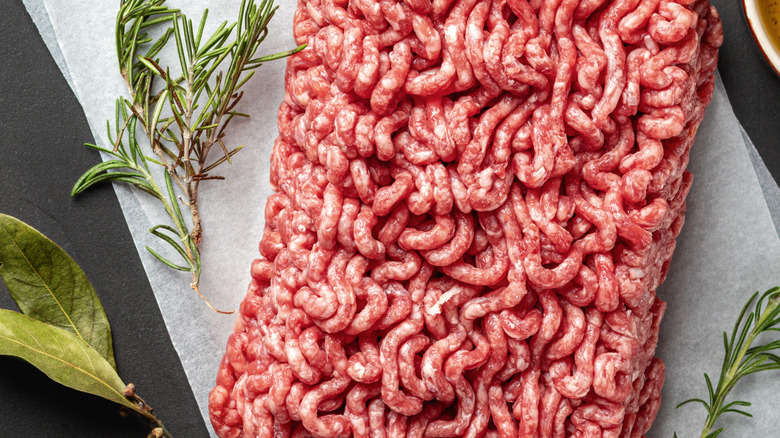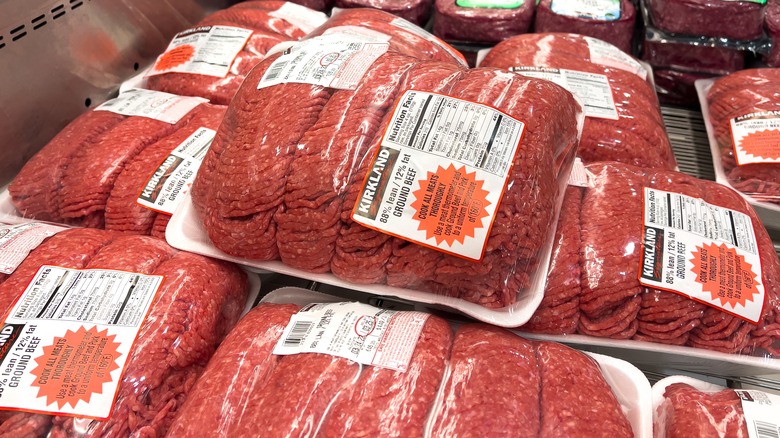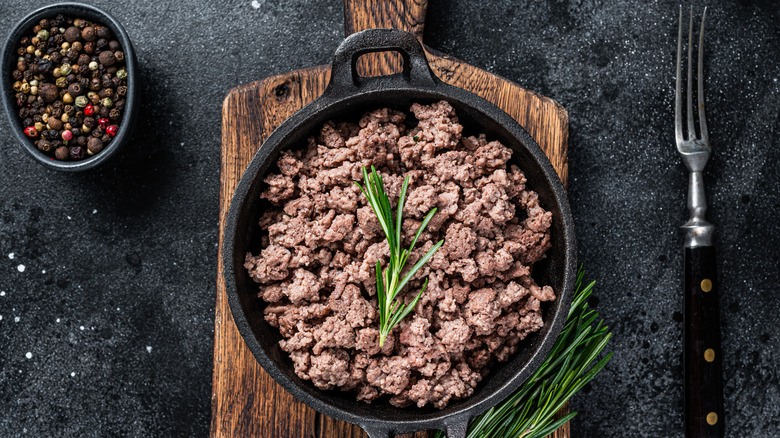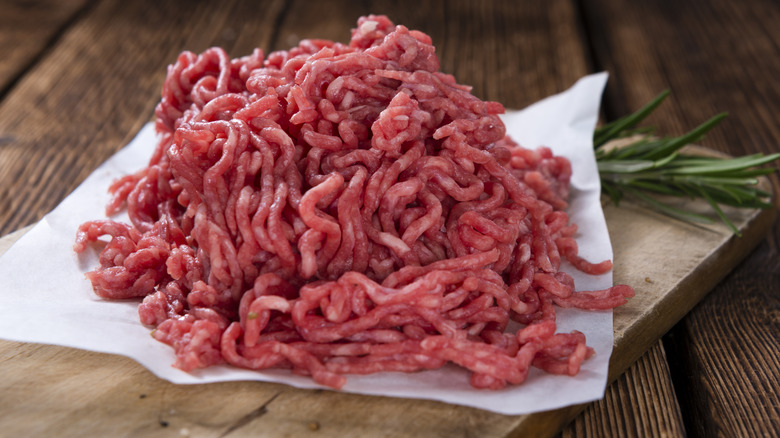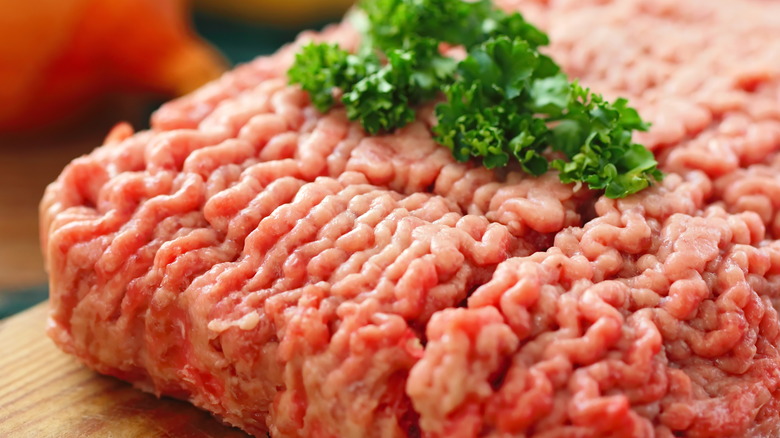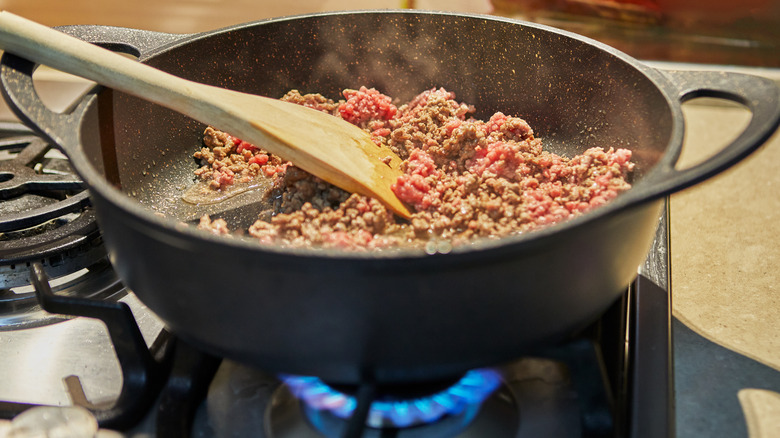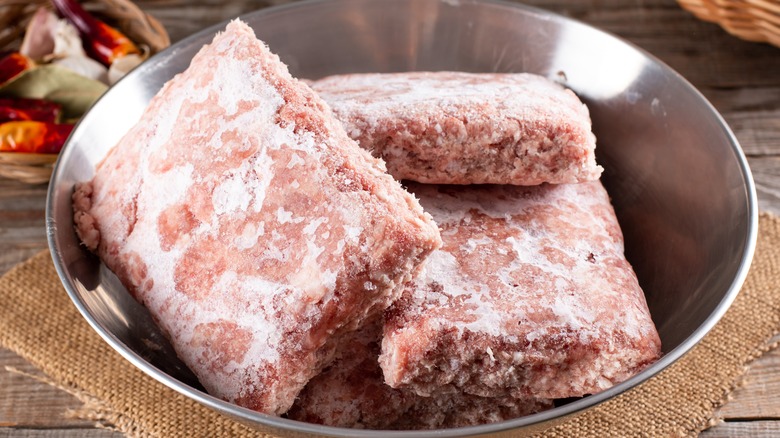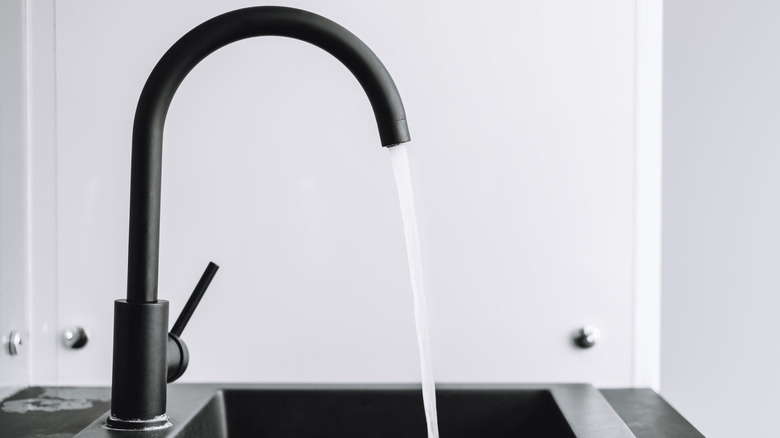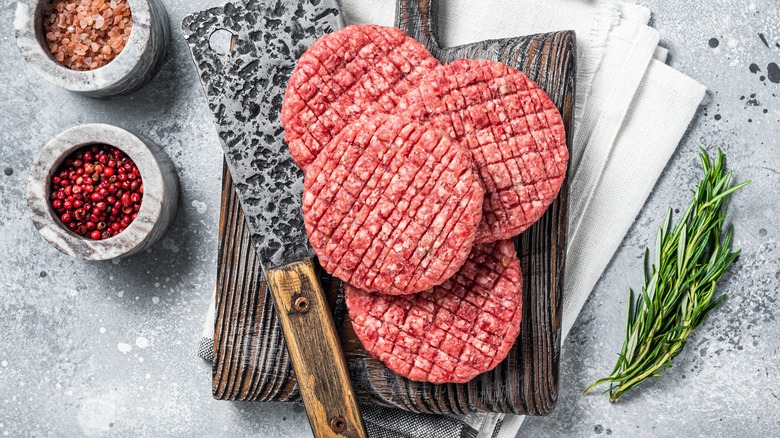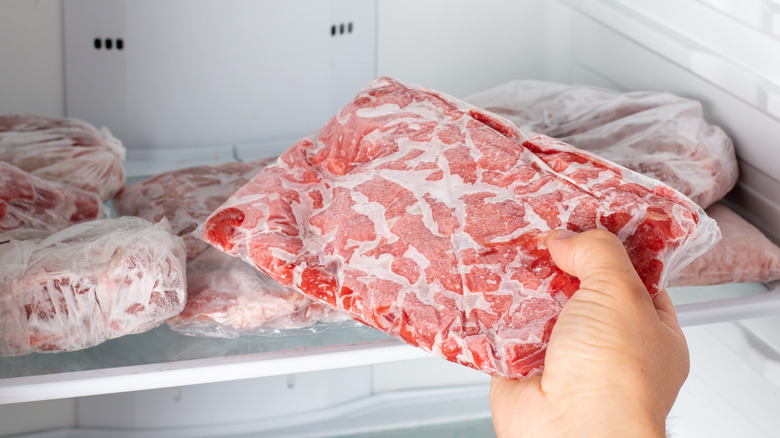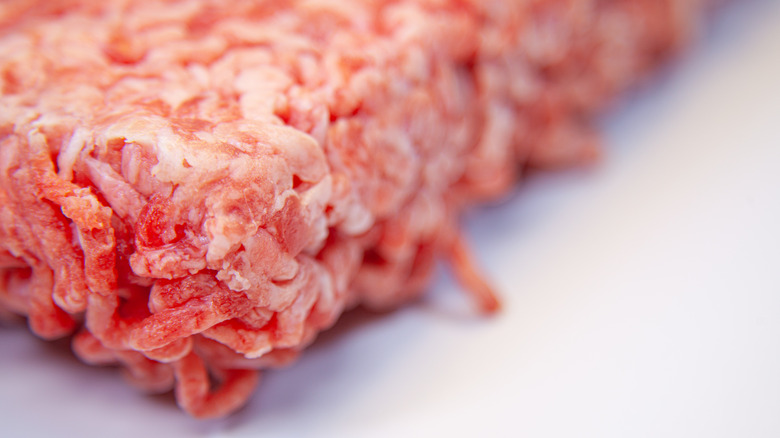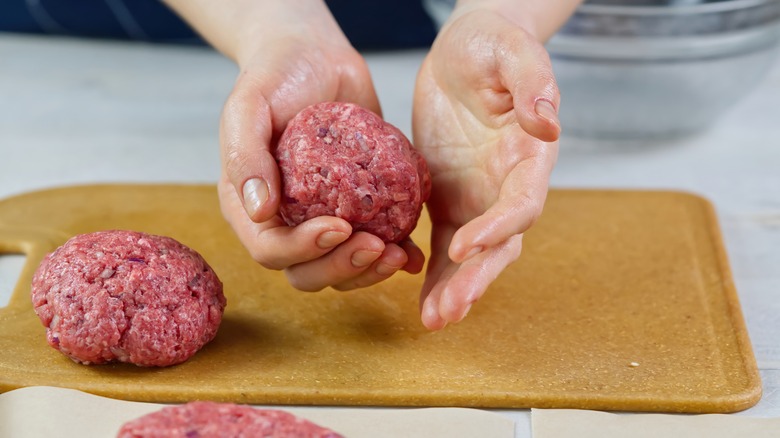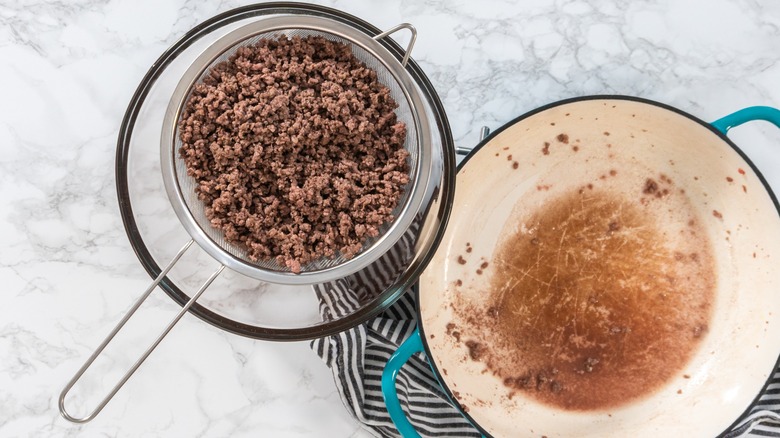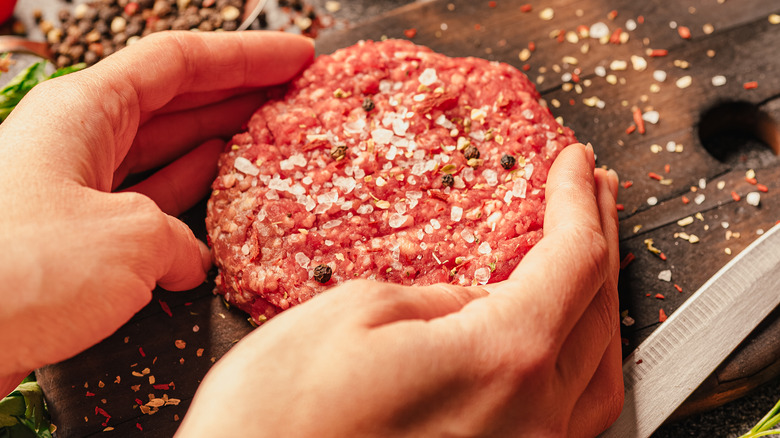13 Mistakes You're Making With Ground Beef
If you eat meat, we're fairly certain that you've eaten ground beef. One of the most ubiquitous ingredients available, ground beef is available in virtually any major food store you care to name, and as the primary source of protein in a huge range of recipes, it's little surprise that it's popular. Ground beef is so widely used that it makes up almost 40% of all beef sales (per Statista), and whether you're making burgers or bolognese, that pack of ground chuck isn't far off.
But while ground beef is used daily across the land, it's not always used well. This catch-all protein may be easy to cook and well suited to many meals, but it's still possible for things to go drastically wrong in its preparation. And when you're dealing with meat — which carries a very real potential for food poisoning when handled or cooked incorrectly — you want to make sure you're getting things just right, so that you can enjoy a delicious meal without the fear of unfortunate repercussions. Let's check out all of the mistakes you're making with ground beef.
1. Buying it at the supermarket
Before you even start preparing your ground beef, you need to think about where it's coming from. And when we say "where," we mean, quite literally, what part of the cow.
The meat that makes up your hamburger can be created from the offcuts of multiple cows, and while ground beef styles like ground chuck are made from a specific part of the animal, other packages of ground beef are created from meat trimmings. Ground beef can even contain elements like the tongue or heart of the cow, according to Pre.
While it's important to point out that this causes no inherent danger or change in taste, if you prefer to know what's going into your ground beef, it's far better to buy it directly from a butcher. By asking a butcher to grind up meat for you, you're able to control what you eventually cook up in your kitchen. You can also select your favorite cuts of meat to be ground up, both in terms of the actual cut (like sirloin or chuck) and in terms of what looks freshest in the store on the day you're buying it.
2. You're not cooking it enough
We all know that ground beef cooks fast. All it takes is a couple of minutes in a pan at high heat, and it should be cooked through and ready to go. But if you get a little impatient with your ground beef, or it's taking the form of a burger, it can arrive at the table a little pink.
While this sometimes isn't an issue (and there are multiple dishes like steak tartare that involves raw or pink ground beef), you have to be super sure that your beef is fresh and free of bacteria. And in the case of ground beef bought from the store, that can be a risky business. Meat can carry bacteria like E. coli, Salmonella, and Enterococcus, and unless it's cooked well, those bacteria can lead to food poisoning (and a nasty night for you in the bathroom, at the very least).
Unless you have a laboratory set up in your home that can test for bacteria, it's pretty hard to determine whether that ground beef has bacteria in it or not. So what can you do? The best thing is to cook it thoroughly. By making sure your beef reaches 160 degrees Fahrenheit in its thickest part, you can lower your chances of bacteria surviving and becoming harmful. With ground beef, this could be as simple as just frying it up well, but with burgers or meatloaf, it could be worth getting an internal thermometer to check.
3. Choosing beef because it looks red
When it comes to meat, it's often a case of "the fresher the better." But knowing how fresh your ground beef actually is can be pretty complicated. And unfortunately, while you might think you can rely on how it looks to discern whether it's fresh or not, a particularly red pack of ground beef doesn't necessarily mean that it's newly prepared.
Many packs of ground beef have carbon monoxide added to them, which serves to preserve the color of the meat, but can fade quickly after being processed (per the American Meat Institute). While carbon monoxide doesn't count as an additive and is perfectly safe to add to ground beef, the problem lies in the fact that redness as an indicator of quality or age can therefore be deceptive.
Instead of using redness to tell whether the beef is fresh or not, pay close attention to the "best by" or "use by" labels. Try as much as possible to pick a pack of beef that has a date further away from when you're going to use it, and when you get home and the package is opened, watch out for any strange smells coming from the meat.
4. Picking beef that's already gone bad
Few things are worse than buying food from the store, bringing it home, and finding out that it's already pretty much inedible due to spoilage. But with foods like ground beef, it can be tricky to discern whether it's bad or not, thanks to the fact that you can't smell or handle it until you've brought it home and taken it out of its packaging. This can lead to some people taking spoiled beef home, risking food poisoning or simply wasting their hard-earned cash.
Thus, while in the store, it's wise to rely on your other senses. If the package of ground beef you've picked up feels warm to the touch or has a gray or brown tinge to it, it's better to avoid it. Ground beef that has gone bad can also begin to sport a slimy texture, though this may be more noticeable once you bring the beef home and are able to handle it.
The key thing to watch out for, though, is any bad smells once you open the package of beef. If it starts to smell a little strange or even sweet, it's a good sign that it's gone bad. In this case, you should throw it out immediately, wash your hands thoroughly, and disinfect any surfaces the beef came into contact with.
5. You're using a small pan to cook it
Let's be real here: Not all of us have industrial-sized cookware, and if you're accustomed to catering for one or two people, you may get by just fine with a small pan. But if you're using it to cook beef, you could potentially be doing your meat a disservice.
The main reason for this is moisture: When a pan has a large surface area, your beef doesn't crowd together, and any moisture that's on the surface of the meat or created in the cooking process can evaporate easily. This allows your beef to brown nicely. However, when the pan is too small, the moisture has nowhere to go, creating steam around the meat and producing excess liquid in the pan. As a result, your meat doesn't fry and brown in the same way. Instead, it sweats, leaving you with grayish ground beef.
Fortunately, there's a simple workaround for this, as chef Rachael Ray points out. If you don't have a big enough pan, just cook it up in batches, removing the cooked beef as you go and setting it aside. That way, you won't overload your cookware, and your beef will brown nicely.
6. Cooking it in its frozen state
Being able to cook food from frozen is a 21st-century convenience some can't live without. But while certain food items like fish sticks, french fries, and even shrimp can be cooked straight from the freezer, other items can't — and frozen ground beef is one of them.
Ground beef, like other meats, has a natural moisture content, and when put in the freezer, that moisture turns to ice. Thus, when you put it in a pan to cook it, the ice melts and subsequently starts to evaporate, drying out your ground beef more than it would if you were cooking it from chilled or at room temperature. Additionally, if you place frozen ground beef in a smaller pan, this moisture may become trapped and turn into water in the pan, and your ground beef can end up stewing instead of sizzling.
There's also the doneness of the meat to consider. Placing a block of frozen beef into a hot pan means that while the outside of the beef may cook, the inside will stay frozen until it thaws completely. Therefore, you may end up with unevenly cooked beef. This is especially problematic if you're cooking ground beef products like burgers from frozen, as they may stay frozen, cold, or raw on the inside while the outside overcooks.
7. Rinsing your beef
Whether you rinse meat before you use it or not is one of the big questions people can have about food prep. But in the case of ground beef, if you're putting it under the kitchen tap, it's a major mistake.
Ground beef — or beef of any form, for that matter – shouldn't be rinsed. Although it might have been useful in days gone by when standards around meat safety were less rigorous, these days, it's perfectly safe to cook meat straight from the pack, unless it's noticeably spoiled (per the USDA).
As a matter of fact, rinsing ground beef is not only pointless, but can also be dangerous. If your ground beef does carry harmful bacteria, rinsing it just spreads that bacteria around your kitchen. That bacteria can either make its way to other food or onto your hands, after which it can enter your system and make you sick. Instead of rinsing your ground beef, focus on your general hygiene in the kitchen. Keep your surfaces and cookware clean and disinfected, and wash your hands before and after handling any food.
8. You're not looking at the fat ratio
In many types of meat (like bacon or steak), you can tell the amount of fat on it simply by looking at it. But with ground beef, it can be a little trickier to figure out. Therefore, it's advisable to look at the fat ratio of the beef, which is usually printed fairly prominently on the packaging.
Doing this not only tells you what you're eating, but is also a good indicator of the eventual moisture levels of the food you're making. When you have an especially juicy burger, for example, one of the reasons that it's so moist is its higher fat content. Conversely, when ground beef is lower in fat, it can become a little dry.
While everyone's taste is slightly different, for the best flavor, a good benchmark to look for is a ratio of 80/20 — 80% beef and 20% fat. This should give you the levels of fat you need to keep things tasty while avoiding your beef getting too greasy or oily.
9. Freezing it incorrectly
If you've bought your ground beef in bulk, firstly, we applaud your commitment to cost-effectiveness. But storing meat that you're not ready to use yet is a lot trickier than, say, stashing some extra cans of beans in the pantry. And just throwing it in the freezer in one big block without packing it properly leaves you having to face defrosting the entire thing when you need to cook it — and the potential for freezer burn to your food.
So, what do you do? Divide your ground beef into individual portions (which, luckily, is easier to do than with other cuts of meat). Then, take each portion and put it into a resealable freezer bag. Flatten the beef down slightly, pushing any air out of the bag, and then seal it shut. Write the date that you did this on the bag (and make it clear to read). Flattening the beef helps to save space in your freezer and allows it to defrost faster, while putting the date on the bag stops you from unintentionally using meat that's seriously old. And of course, portioning it out results in you being able to use just what you need for a recipe.
10. You're defrosting it on the countertop
So, you're a few hours away from cooking dinner, and you suddenly remembered that the block of ground beef you need for it is sitting in the freezer, frozen rock-solid. Don't worry, we've all been there. Surely, though, leaving it to sit on the countertop at room temperature solves that problem, right?
Well, while it may indeed defrost your meat, it may not do so in the safest way. Leaving food out to defrost can increase the risk of harmful bacteria, which may lead to contamination of other food or illness. Instead, the safest way to defrost meat is by putting it in the fridge. This controls the rate that it defrosts, and therefore limits the risk of the meat becoming contaminated.
Bear in mind, however, that although ground beef can defrost faster than other, denser meat products, it may still take up to a day to fully thaw in the fridge, so make sure you plan ahead.
11. Try not to overmix
One of the true joys of ground beef is how many recipes it can be used in. From tacos to chili to shepherd's pie, ground beef has been added and enjoyed time and time again. But the MVP of ground beef recipes? It's gotta be burgers, folks. Forming juicy patties and grilling them to smokey perfection ... Excuse us while we grab an apron.
But, although making burgers seems easy (you just push the beef together and cook, right?), there's actually a fine art to it. And overmixing your ground beef to make burgers is a big no-no. A curious thing happens when you overmix beef to make burgers: Instead of coming together more cohesively, it increases the likelihood of them breaking apart. Overmixing prevents the meat from binding effectively, which is key to achieving a perfect patty.
The trick is to stop mixing earlier than you might think. Only mix until your meat has combined with the rest of your ingredients, and then make it into patties. Remember, too, that ground beef with a lower fat content will dry out faster than meat that's higher in fat.
12. You shouldn't drain it in the sink
One of the trickiest things about cooking ground beef is the amount of liquid it can release, and when this liquid comes in the form of fat, you run the risk of making your meal much greasier than you want it to be. Because of this, draining ground beef has become a common practice, and some folks simply put their beef in a strainer and pour the fat down the sink.
Unfortunately, this is one of the worst mistakes you can make. While beef fat is liquid when it's piping hot, it becomes solid again as it cools. This means that the liquid fat making its way down your sink will solidify in your pipes. This can lead to blockages, a tricky clean-up operation, and potentially a phone call to the plumber.
So, save yourself the hassle, and drain your beef properly. Allow the beef to cool slightly, and then strain or pour the fat directly into a disposable container or heat-proof bowl. Then, once it's at room temperature, take the solid mass and throw it in the trash. If it's a little late for that and you've strained your beef in the sink, don't panic. Boil some water and pour it down the drain, while also squirting some dish soap in. This will cause the fat to turn to liquid and emulsify, clearing and cleaning your pipes.
13. Don't season it at the wrong time
Well-seasoned beef is a glorious thing. But although you may think it's as simple as just throwing salt and spices in at whichever point you choose, it's a little more complicated than that.
Seasoning ground beef incorrectly can lead to a change in the meat's texture (and affect your eventual enjoyment of the food you're making). This is specifically a problem when making hamburgers. It might seem logical that you put seasonings directly into the meat before forming patties, but if those seasonings include salt, it can have an adverse effect on the protein molecules in the beef. These molecules will start to break down, leaving you with a tougher patty.
To avoid this, make sure that you're only adding salt on the surface of your patty right before you put it on the grill or in the pan. This will add a bit of flavor to the meat, while preventing its texture from deteriorating.
